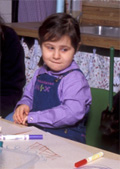Handout 3b.5sh
Behavior Hypotheses
 When Sashi is in unstructured activities (centers), she will begin
to mouth toys/objects by either sucking or chewing on them.
When this behavior occurs, children will bring attention to the
mouthing by either yelling out that it is gross or yucky or by
getting a teacher. Sashi will then gain adult attention. A teacher
will then give Sashi assistance by going over to Sashi, helping
her take the toy to the “dirty bucket,” and redirecting Sashi to
another activity and help her play.
When Sashi is in unstructured activities (centers), she will begin
to mouth toys/objects by either sucking or chewing on them.
When this behavior occurs, children will bring attention to the
mouthing by either yelling out that it is gross or yucky or by
getting a teacher. Sashi will then gain adult attention. A teacher
will then give Sashi assistance by going over to Sashi, helping
her take the toy to the “dirty bucket,” and redirecting Sashi to
another activity and help her play.
Sashi will pull items (bows, ribbons, clips…) out of hair, to initiate social interaction, as people enter the playground and when they are sitting or playing nearby. When this behavior happens, children scream, and an adult gives Sashi attention by running to her and telling her “No!” and then helping her play.
When Sashi is asked to do an activity that is difficult or undesirable (table activities, sitting in circle), she will attempt to escape the activity by resisting walking, by pulling away, and/or by dropping to the ground. When this behavior occurs, adults will decrease their demands or leave her where she is to play.
When Sashi is asked to transition from one activity to another (sensory table to art, circle to small group) or when she is asked to sit for more than 1-2 minutes (circle, table activities), she will begin wandering around the classroom to delay or escape the transition. After Sashi has wandered for about 30 seconds to 1 minute, an adult will go to her and try to redirect her back to the activity. When she then drops to the ground, she is most often left alone.
We welcome your feedback on this Training Module. Please go to the CSEFEL Web site (http://csefel.uiuc.edu) or call us at (217) 333-4123 to offer suggestions.
About Us | Contact Us | Resources | Chat | Primary Partners & CCTAN | Site Map | Search | Home




